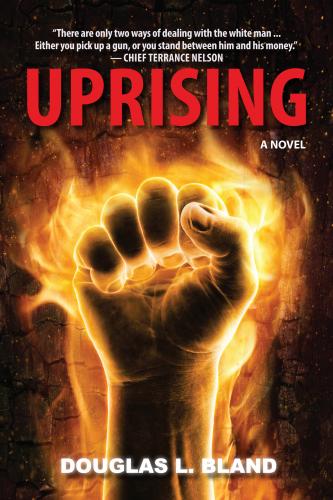“So, let me put our vulnerabilities on the table and then we can link it to Walter’s bold-move option. I brought some copies of the charts we used to brief the minister. Would you pass them around please?
“You all know it’s a big mistake to underestimate your adversary or to assume he won’t think of things because you can’t handle them or it screws up your plans. I’m going to start by assuming that the native leaders see our vulnerabilities the same way we do, and that they are going after them the way we would. Thus, raids on the cities will be dramatic, but the big Western target, because it is Canada’s great economic vulnerability, will be the resource industries, especially the gas and oil pipelines running to eastern Canada and south into the U.S. I believe the Movement leaders think that if they can threaten these, it will bring the federal government to the table quickly, and if the government hesitates, the destruction of a few key sites will bring them around even quicker. That’s why we don’t agree and can’t assume that the government can simply wait them out. And the Movement knows that too.
“It’s not a matter of some Indians squatting in the bush shouting slogans. Canadian natural gas and petroleum industries deliver the lifeblood to North America’s economy. They’re the critical components of the well-being of millions of Canadians and Americans even if we don’t always notice them. They’re especially important to the northeast, northwest, and west coast American markets, and they have to operate constantly or we’re in trouble fast. And it’s not just us. Ninety-five percent of Canadian natural gas production is exported to the United States through six great pipelines; that’s a full fifteen per cent of U.S. requirements, and that number is growing fast.
“The loss of gas or oil supplies, even for only a few days, would have a devastating and cascading effect across the entire United States. A long interruption in the West could, according to some estimates we have seen, plunge the United States into an irreversible depression.
“But the dependence and thus the vulnerability do not reside only in the American West. A complete loss of natural gas and oil supplies would cripple the economies of Ontario, parts of Quebec, and particularly Montreal. Furthermore, quite apart from the indirect impact of economic collapse in the far western American states, significant disruption of the pipelines would starve Minnesota, Wisconsin, Michigan, New York, and Connecticut, and likely shut down manufacturing industries in Detroit and across the northern states as well.
“Should these interruptions occur any time between early October and May, a man-made winter disaster of enormous danger would engulf the entire northern tier of North America. Our vulnerabilities here are enormous.
“The four main pipelines – the Duke line to British Columbia, the TransCanada line from the northern and central Alberta fields to the eastern United States and Canada, the BP line into Washington State and California, and the TransGas line from Alberta and Saskatchewan – are the easiest and softest targets. In all, 38,000 kilometres of natural gas pipelines snake out of the Alberta/Mackenzie River valley western sedimentary basin, moving eighty per cent of Canada’s gas production to markets in Canada and the United States. The system includes not just the pipes above and in the ground, but also more than 115 large, complex compressor stations that drive the gas through the lines to its destination. There’s one about every 330 kilometres along the whole system. The compressor stations are the weakest link in a weak system.
“And you can add to this maze another 70,000 kilometres of oil pipelines. They aren’t guarded and there’s no way to guard them. I’d bet the mortgage that Stevenson will go for a few compressor stations first as a warning, creating damage easy to fix if we give in promptly, but he’ll start smashing up the whole system if we try any systematic attack on the native forces.”
“Surely we’ve done something to protect the system, especially after 9/11,” said Maggie. She pointed to Hugh’s maps and charts. “I can’t believe that we’ve just sat on our collective asses and hoped for the best.”
“Well, Maggie, the government did move quietly after 9/11 to enhance security at vital points across the country, but serious measures were taken only on military bases and at particularly vital points in Ottawa and major financial computing centres in Montreal and Toronto. Elsewhere, only ‘get ready’ warning orders have been passed to police detachments and to the Canadian Forces Reserve units. Even then, the prime minister in 2004 ordered that no overt actions be taken anywhere for fear of worrying citizens and disrupting investments.”
Eliot rejoined the discussion. “Nothing of consequence has been done to protect the energy transportation system. Not that anything really can be done to make the system perfectly secure.
“Sorry folks, but this situation is really bad and we have to assume the Movement knows it. I think the politicians are the only ones who don’t, or won’t, accept it. If we can’t protect our vulnerabilities, we have to reconsider countering the threats to them instead. That’s why we’re here.
Конец ознакомительного фрагмента.
Текст предоставлен ООО «ЛитРес».
Прочитайте эту книгу целиком, купив полную легальную версию на ЛитРес.
Безопасно оплатить книгу можно банковской картой Visa, MasterCard, Maestro, со счета мобильного телефона, с платежного терминала, в салоне МТС или Связной, через PayPal, WebMoney, Яндекс.Деньги, QIWI Кошелек, бонусными картами или другим удобным Вам способом.
